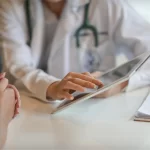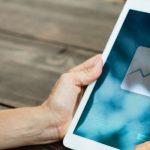9 Digital healthcare predictions for 2019
Wellness wearables, AI, healthcare in the cloud and more. Let’s take a look at what 2019 holds for technological innovations shaping the future of health.
1. AI-enabled healthcare ecosystem
Artificial intelligence (AI) is gaining significant momentum in healthcare and is forecast to have the potential to significantly transform the industry, as well as the way practitioners interact with their patients.
A PWC report released earlier this year, has already revealed how AI is already being leveraged by back offices and supply chains, generating quiet efficiencies. Meanwhile a McKinsey report released in February this year found AI and robotics present huge opportunities for both the pharma and healthcare industries. The report found big data strategies could save the US healthcare system alone, up to $100 billion a year thanks to AI-assisted efficiencies in trials, research, and clinical practice.
But while disruptive technologies, AI and machine learning can be powerful tools to drive better health outcomes for the year ahead, MedicalDirector’s CO, Matthew Bardsley warns that in a fear-based economy, the AI-enabled predictions need to be fully understood within the context of each individual person and their circumstances.
“For AI to really be a powerful tool in healthcare and enabler of better health outcomes, we need to make sure it is done respectfully, there is a level of empathy in the system, and a layer of emotional artificial intelligence, before it can be unleashed into the healthcare ecosystem,” he explained. “Otherwise just one health prediction delivered incorrectly can lead to a life or death situation for a patient, and stifle innovation.”
“Moving forward, innovators in healthcare need to understand and respect this layer of emotional AI required, and really lean into this problem and understand its repercussions, so healthcare can enjoy the same capabilities as other parts of the market.
2. VR and medical training
Virtual reality is set to change the lives of patients and physicians alike in the year ahead. Already, Embodied Labs’ “We Are Alfred” uses VR technology to show young medical students what ageing means. Everyone can be the hypothetical ‘Alfred’ for 7 minutes, and experience how it feels like to live as a 74 year-old man with audio-visual impairments. The technology’ goal is to solve the disconnection between young doctors and elderly patients due to their huge age difference.
Meanwhile giving birth has also been propelled into the virtual space with new innovations in both virtual reality and augmented reality developed by the University of Newcastle (UON). Using the Samsung GearVR and HTC Vive (VR) and HoloLens (AR) headsets, UON students will be among the first in the world to learn key anatomy changes, birthing techniques and real-world emergency scenarios via virtual and augmented simulation
“The real potential I see with virtual reality is how it can facilitate education and learning in General Practice,” MedicalDirector’s Chief Clinical Advisor and General Practitioner, Dr Charlotte Middleton said. “There are some great innovations in this area, that are set to be rolled out and developed even further as fantastic health education tools.
“Personally, I think it will also open up exciting new opportunities to better facilitate patient engagement, and offer a more personalised approach to the patient experience. It’s an innovative way for patients to understand more about their condition, treatment or what to expect in their upcoming procedure.”
3. Internet of medical things (IoMT)
It is predicted we will continue to see the development of IoT-enabled medical devices in 2019, and already, internet-connected devices have been introduced to patients in various forms.
Patients and providers both stand to benefit from IoT, whether they’re using mobile medical applications or wearable devices to capture health data, or keeping tabs on the location of medical devices, personnel and patients.
For instance, one innovation that Dr Middleton came across at the recent Creative Careers in Medicine event that impressed her was brand new sensor technology, which monitored movement behaviour in the home.
“You can place these sensors in the bedroom, bathroom, kitchen and living room, for instance, and on appliances that are used regularly, such as the fridge, kettle and microwave,” Dr Middleton explained. “These devices can gather information about the normal movement of someone, within the home like their eating patterns. This data is then fed back into an app which the patient’s doctor and/or family can monitor on their smartphone.
“If there’s any disruption in patterns of behaviour, an alert is released. This type of new, data-driven technology is fantastic because it can really help quicken the response rate to health emergencies in aged care, reduce hospitalisation and have a direct impact on patient health.
4. Smart health monitors and wellness wearables
The proliferation of digital wellness devices and apps has signaled a new era in more individuals closely tracking their fitness and health than ever before. In fact, a recent report from Flurry Analytics, found health and fitness app usage has become increasingly popular, growing over 330% in just 3 years.
At the same time, IoT will play a more significant role in enabling flexible, outcome-based care, including wearables, digestible and implantables.
Already, there are new innovative devices including ultrasounds, ECG monitors, microscopes and dermatoscopes that can view skin cancers and blood pressure monitors that can be plugged into a smartphone. A picture of an inner ear or throat taken on a smart phone can help a doctor diagnose and infection. There are even smart health devices and wearables to track and monitor lung health and medication usage for asthma patients.
On top of this, mobile devices can perform ECGs, DIY blood tests, or serve as a thermometer, all without even leaving the house. And with help from automation, patients can even be prompted to check their weight, pulse, or oxygen levels, and enter results into mobile patient portals. They can transmit the results to my doctor in real time.
Those details, when entered regularly, can help predict one’s risk for heart disease and other illnesses, ultimately saving lives. One app even allows you to scan your vital signs just by placing the phone on your forehead to measure heart rate, and body temperature.
“The age of wellness wearables is definitely here,” Dr Middleton said. “Whether it is the middle ear devices that monitor your heart rate, the wearables on your wrist that tell you how you’re sleeping, or the ECG monitors that go around your chest – there are so many exciting technology concepts that can really enhance the care we provide as doctors.”
According to MedicalDirector’s CEO Matthew Bardsley, as a result of this increased wellness digital usage, individual users now have a wealth of data on their own wellbeing at their fingertips, making them far more empowered and equipped to track and monitor their own health and to some extent, even self-diagnose.
“Technology is now not only giving people incentive to become more deeply involved and interested in their own health, but they can easily share these data sets with their health practitioners in a far more accurate and structured way,” he said. “This means for the first time, the information asymmetry is changing where digitally agile patients will now have far more personal health tracking data on their own devices than their practitioner has on file. And it’s nothing to be afraid of. In fact, there are many mid-term and long-term benefits.”
5. Therapeutic apps to improve health outcomes
‘Digiceuticals’ are set to have a profound impact on the future of health and patient outcomes. Unlike mainstream ‘wellness apps’, digiceuticals have been tested for efficacy, approved by regulatory agencies such as the FDA and are prescribed by medical practitioners.
Most digiceuticals gather specific health data, either by asking patients for information or by using sensors, and provide real-time guidance. For instance, diabetes apps can work with connected monitors and use the information to manage symptoms.
“I really can see the benefits of ‘prescribing’ these therapeutic apps to our patients,” Dr Middleton said. “It’s these sort of patient-centric innovations that will help to improve patient engagement and health outcomes moving forward.”
6. Virtual care and the future of health
Virtual care, otherwise known as telehealth, is the delivery of health-related services and information via technology outside the physical ‘walls of the ‘consulting room’, and is increasingly becoming a critical enabler of more personalised, patient-centric care.
Forrester’s study, Virtual Care Enables The Digital Health Imperative, predicts virtual care is set to disrupt today’s outpatient visit and chronic disease management program models. And in its latest predictions report, Predictions 2019: In Healthcare, CX Measurement Frameworks, Virtual Care, And AI Come To The Fore, Forrester predicts virtual care will be crucial to patient acquisition and retention.
In 2019, a new report commissioned by Philips, Telehealth: delivering value across institutional and geographical borders, revealed while there is an appetite for telehealth in the industry, there are some barriers to adoption, including implementation and integration time and costs.
Healthcare professionals need to see how telehealth will make a process more efficient or error-free, while patients must understand how it contributes to a more convenient or cost-effective experience, the report stated.
“There are so many ways now to practice medicine ‘outside of the consulting room’, which is particularly useful for to support rural and mental health patients, who are either physically or psychologically unable to reach a face-to-face consultation,” Dr Middleton said. “Plus technological innovations are popping up every day to complement virtual care in Australia. For instance, there are technologies that can match patients with clinical trials or to psychologists. Technology is becoming more accepted as an effective way health professionals can connect with patients to enable better health outcomes.”
7. Healthcare in the cloud
Innovative cloud-based practice management solutions are set to continue gaining momentum over server-based practice management, as they support increased collaboration in healthcare, allowing multiple stakeholders to share information securely and seamlessly across the network. At the same time, cloud-based platforms will enable more empowered use of data, with technology enabling practitioners to better collect, manage, analyse and share relevant data within the healthcare ecosystem.
MedicalDirector’s recent whitepaper, Interoperability in healthcare: Synergising an industry, found a significant benefit of moving towards cloud-based solutions is that it supports more interoperable systems, which in turn benefits coordinated care and improved patient outcomes.
The report further revealed cloud-based health solutions provide the digital infrastructure needed to effectively coordinate more flexible patient-centric care. When it comes to the cloud, 64% of respondents admitted they consider flexibility to be the main benefit of using a cloud-based HER/PMS systems, enhancing the workflow capabilities of care teams and improving the patient experience.
“A key benefit of cloud health software is that it supports better real-time communication,” Dr Middleton said. “For instance, it supports digital referrals, faster communication between primary healthcare providers and hospitals, as well as better communication between GPs and allied health providers. Ultimately, it is this real-time benefit of cloud software that helps support interoperability in the wider health ecosystem.
8. Genomic testing and precision medicine
Genomics is becoming increasingly more pervasive in the future of healthcare, as more government bodies and healthcare organisations start preparing for a new era of precision medicine.
A recent report released from the Australian Council of Learned Academies (ACLA), The Future of Precision Medicine, predicts Australians will be able to have their genomes mapped within the next 25 years, and health systems will be required to offer this high tech test, as healthcare moves more towards a focus on preventing diseases
Precision medicine, the report said, encompasses a broad remit, including genomics and other ‘omics’ (metabolomics, microbiomics, proteomics and transcriptomics), epigenetics, gene editing technologies such as CRISPR and the development of targeted therapies specific to an individual’s disease profile.
And advances in genome sequencing and the associated field of genomics are set to offer us better understanding of how diseases affect different individuals. With the genetic profile of a person’s disease, and knowledge of their response to treatment, it should be possible to find out more about the likely effectiveness of medical interventions such as prescribing drugs to treat a disease (pharmacogenomics).
“I definitely see genomics, precision medicine and personalised medicine as being part of the future of medicine,” Dr Middleton said. “But at the same time, we have to ensure there are evidence-based systems in place to ensure we obtain true results we can trust and act upon.
“The information we obtain is astronomical and can have a profound impact on a patient’s health and psyche – in terms of what you may be revealing to them that they’re pre-disposed to. So we need to give our approach to genomics a lot of thought and develop some fail-safe protocols behind using it.”
9. Blockchain and healthcare
In 2017, we predicted that 2018 will see blockchain technology will move from media hype to a core reality for healthcare management with the debate moving onto how the technology will really impact the operations management, patient identity and record management.
Already, the Garvan Institute announced it is investigating whether blockchain technology can be used to help citizens get more control over their health data. Meanwhile in the US, blockchain technology is already being utilised for medical records by establishing a secure distributed medical records system in an effort to tighten security and privacy.









